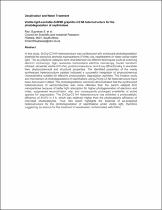 ResearchSpace
ResearchSpace
Visible light-excitable ZnO/2D graphitic-C3N4 heterostructure for the photodegradation of naphthalene
JavaScript is disabled for your browser. Some features of this site may not work without it.
- ResearchSpace
- →
- Research Publications/Outputs
- →
- Journal Articles
- →
- View Item
| dc.contributor.author |
Mukwevho, N

|
|
| dc.contributor.author |
Kumar, Neeraj

|
|
| dc.contributor.author |
Fosso-Kankeu, E

|
|
| dc.contributor.author |
Waanders, F

|
|
| dc.contributor.author |
Bunt, J

|
|
| dc.contributor.author |
Ray, Suprakas S

|
|
| dc.date.accessioned | 2020-03-19T12:11:12Z | |
| dc.date.available | 2020-03-19T12:11:12Z | |
| dc.date.issued | 2019-09 | |
| dc.identifier.citation | Mukwevho, N. et al. 2019. Visible light-excitable ZnO/2D graphitic-C3N4 heterostructure for the photodegradation of naphthalene. Desalination and Water Treatment, vol. 163, pp. 286-296 | en_US |
| dc.identifier.issn | 1944-3994 | |
| dc.identifier.issn | 1944-3986 | |
| dc.identifier.uri | https://www.deswater.com/vol.php?vol=163&oth=163%7C0%7CSeptember%20%7C2019 | |
| dc.identifier.uri | https://doi.org/10.5004/dwt.2019.24422 | |
| dc.identifier.uri | https://www.deswater.com/DWT_abstracts/vol_163/163_2019_286.pdf | |
| dc.identifier.uri | http://hdl.handle.net/10204/11365 | |
| dc.description | Copyright: 2019 Desalination Publications. Due to copyright restrictions, the attached PDF file only contains the abstract of the full text item. For access to the full text item, please consult the publisher's website. The definitive version of the work is published in Desalination and Water Treatment, vol. 163, pp. 286-296 | en_US |
| dc.description.abstract | In this study, ZnO/g-C(sub3)N(sub4) heterostructure was synthesized with enhanced photodegradation potential for polycyclic aromatic hydrocarbons (PAHs) (viz. naphthalene) in water using visible light. The as-prepared catalysts were characterized via different techniques such as scanning electron microscopy, high resolution transmission electron microscopy, fourier transform infrared, ultraviolet visible (UV-Vis), photoluminescence, and X-ray diffractometry to elucidate their physicochemical and structural properties. The identified properties of the newly synthesized heterostructure catalyst indicated a successful integration of physicochemical characteristics suitable for effective photocatalytic degradation activities. The kinetics study and mechanism of photodegradation of naphthalene using ZnO/g-C(sub3)N(sub4) heterostructure have been discussed in detail. The photodegradation outcomes demonstrated that the synthesized heterostructure of semiconductors was more effective than the parent catalyst ZnO nanoparticles because of better light absorption for higher photogeneration of electrons and holes, suppressed recombination rate, and consequently prolonged availability of active species for degradation. The ZnO/g-C(sub3)N(sub4) heterostructure has exhibited a photocatalytic efficiency of 84.5% in 4 h, which was relatively higher than the photocatalytic efficiency of individual photocatalysts. Thus, this report highlights the potential of as-prepared heterostructure for the photodegradation of naphthalene under visible light, therefore suggesting an avenue for the treatment of wastewater contaminated with PAHs. | en_US |
| dc.language.iso | en | en_US |
| dc.relation.ispartofseries | Workflow;23349 | |
| dc.subject | Zinc oxide | en_US |
| dc.subject | g-C3N | en_US |
| dc.subject | Photocatalysts | en_US |
| dc.subject | Water pollution | en_US |
| dc.subject | PAHs | en_US |
| dc.subject | Naphthalene | en_US |
| dc.title | Visible light-excitable ZnO/2D graphitic-C3N4 heterostructure for the photodegradation of naphthalene | en_US |
| dc.type | Article | en_US |
| dc.identifier.apacitation | Mukwevho, N., Kumar, N., Fosso-Kankeu, E., Waanders, F., Bunt, J., & Ray, S. S. (2019). Visible light-excitable ZnO/2D graphitic-C3N4 heterostructure for the photodegradation of naphthalene. http://hdl.handle.net/10204/11365 | en_ZA |
| dc.identifier.chicagocitation | Mukwevho, N, Neeraj Kumar, E Fosso-Kankeu, F Waanders, J Bunt, and Suprakas S Ray "Visible light-excitable ZnO/2D graphitic-C3N4 heterostructure for the photodegradation of naphthalene." (2019) http://hdl.handle.net/10204/11365 | en_ZA |
| dc.identifier.vancouvercitation | Mukwevho N, Kumar N, Fosso-Kankeu E, Waanders F, Bunt J, Ray SS. Visible light-excitable ZnO/2D graphitic-C3N4 heterostructure for the photodegradation of naphthalene. 2019; http://hdl.handle.net/10204/11365. | en_ZA |
| dc.identifier.ris | TY - Article AU - Mukwevho, N AU - Kumar, Neeraj AU - Fosso-Kankeu, E AU - Waanders, F AU - Bunt, J AU - Ray, Suprakas S AB - In this study, ZnO/g-C(sub3)N(sub4) heterostructure was synthesized with enhanced photodegradation potential for polycyclic aromatic hydrocarbons (PAHs) (viz. naphthalene) in water using visible light. The as-prepared catalysts were characterized via different techniques such as scanning electron microscopy, high resolution transmission electron microscopy, fourier transform infrared, ultraviolet visible (UV-Vis), photoluminescence, and X-ray diffractometry to elucidate their physicochemical and structural properties. The identified properties of the newly synthesized heterostructure catalyst indicated a successful integration of physicochemical characteristics suitable for effective photocatalytic degradation activities. The kinetics study and mechanism of photodegradation of naphthalene using ZnO/g-C(sub3)N(sub4) heterostructure have been discussed in detail. The photodegradation outcomes demonstrated that the synthesized heterostructure of semiconductors was more effective than the parent catalyst ZnO nanoparticles because of better light absorption for higher photogeneration of electrons and holes, suppressed recombination rate, and consequently prolonged availability of active species for degradation. The ZnO/g-C(sub3)N(sub4) heterostructure has exhibited a photocatalytic efficiency of 84.5% in 4 h, which was relatively higher than the photocatalytic efficiency of individual photocatalysts. Thus, this report highlights the potential of as-prepared heterostructure for the photodegradation of naphthalene under visible light, therefore suggesting an avenue for the treatment of wastewater contaminated with PAHs. DA - 2019-09 DB - ResearchSpace DP - CSIR KW - Zinc oxide KW - g-C3N KW - Photocatalysts KW - Water pollution KW - PAHs KW - Naphthalene LK - https://researchspace.csir.co.za PY - 2019 SM - 1944-3994 SM - 1944-3986 T1 - Visible light-excitable ZnO/2D graphitic-C3N4 heterostructure for the photodegradation of naphthalene TI - Visible light-excitable ZnO/2D graphitic-C3N4 heterostructure for the photodegradation of naphthalene UR - http://hdl.handle.net/10204/11365 ER - | en_ZA |





